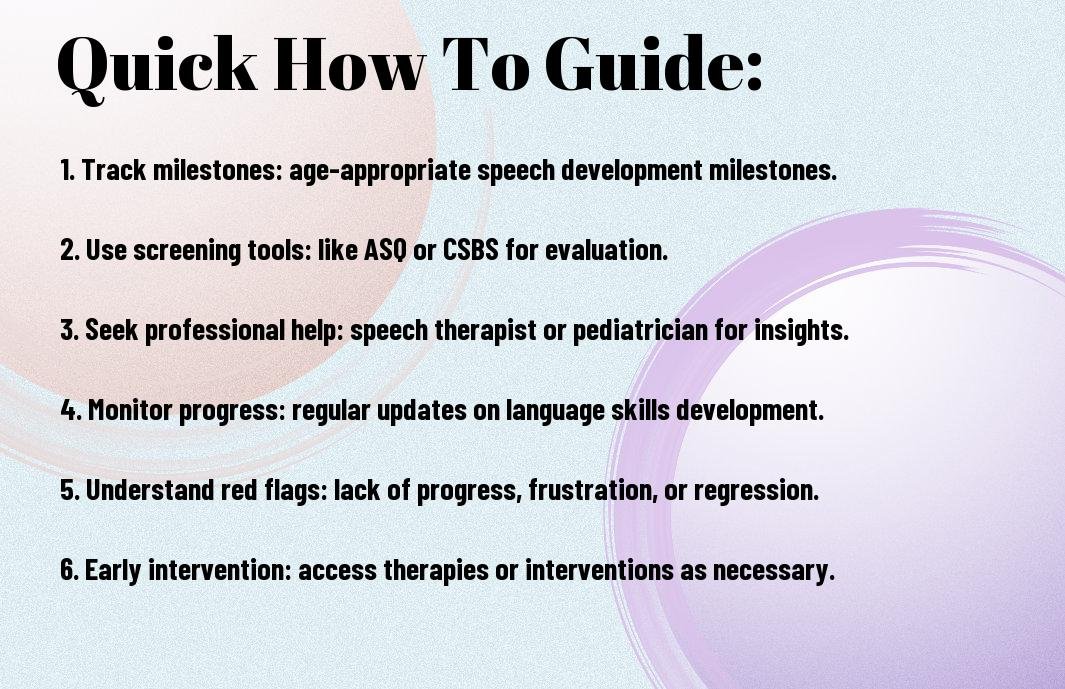This guide will help parents navigate the tricky waters of identifying speech delays in their children. It is normal for kids to develop speech at their own pace, but recognizing when there might be an issue is crucial. Understanding the signs of delay versus typical development can profoundly impact a child’s communication skills and overall well-being.
Table of Contents
Key Takeaways:
- Early identification is crucial: It is important to recognize the signs of speech delays in young children to provide early intervention.
- Monitor developmental milestones: Tracking a child’s progress in reaching speech and language milestones can help differentiate between normal development and delays.
- Seek professional evaluation: If there are concerns about a child’s speech development, consulting with a speech-language pathologist or pediatrician for an evaluation can provide insight and guidance.
- Consider communication in context: Evaluating a child’s overall communication skills, including nonverbal cues and interactions, can help determine if delays are present.
- Encourage language enrichment: Engaging children in activities that promote language development, such as reading, singing, and storytelling, can support speech growth and help address delays.


Understanding Normal Speech Development
Typical Milestones in Speech Development
A child’s speech development follows a typical pattern, starting with cooing and babbling around 6 months, followed by single words at 12 months, and two-word phrases by 24 months. By the age of 3, children should be able to speak in short sentences and be understood by strangers.
Factors Influencing Normal Speech Development
Speech development can be influenced by various factors such as genetics, exposure to language, and cognitive abilities. Children who are spoken to frequently, read to, and encouraged to communicate tend to develop speech skills faster. This helps in building a strong foundation for communication and language skills in the future.
- Genetics: Family history plays a role in speech development.
- Language exposure: Being exposed to a rich language environment enhances speech skills.
- Cognitive abilities: Children with strong cognitive skills tend to excel in speech development.
Plus
Understanding normal speech development is crucial for caregivers to track a child’s progress accurately. Recognizing typical milestones and being aware of factors that influence speech development can help in early identification of any delays. Early intervention in case of delays can greatly improve a child’s speech and language abilities in the long run.
Identifying Red Flags for Speech Delays
It is crucial for parents and caregivers to be able to recognize potential red flags for speech delays in young children. Early intervention is key in addressing speech delays and supporting a child’s language development.
Common Indicators of Speech Delays in Infants
Delays in speech development for infants can include a lack of response to sounds, limited cooing or babbling, and difficulty with feeding or swallowing. If you notice any of these signs, it may be a good idea to consult with a pediatrician or speech-language pathologist.
Warning Signs of Speech Delays in Toddlers and Preschoolers
Now in toddlers and preschoolers, Warning Signs of speech delays can manifest as limited vocabulary, difficulty forming sentences, unclear speech that is hard to understand, and struggles with rhyming or identifying sounds in words. Parents should also be aware of any frustration or behavioral issues related to communication difficulties.
Plus, if a child is not showing progress in their speech and language skills or if there is a family history of speech delays, it is important to seek guidance from a professional to determine the best course of action.

How to Assess Speech Development
Tips for Observing Speech Patterns in Children
Unlike speech delays, normal speech development follows a predictable pattern. Listen to how your child articulates words, the complexity of sentences they use, and their ability to communicate needs and wants.
- Pay attention to how your child pronounces words
- Observe how they string words together to form sentences
- Take note of their ability to follow directions and engage in conversation
Recognizing red flags early on can help in addressing any speech development issues promptly.
Effective Communication Strategies for Assessment
Even if a child is not speaking as expected for their age, there are ways to effectively communicate to assess their understanding and receptive language skills. Use simple and clear language, provide visual cues, and repeat information when necessary to ensure comprehension.
Assess the child’s response to different communication strategies to determine the best approach for assessing their speech and language development.
Factors Contributing to Speech Delays
All children develop speech at their own pace, but sometimes delays can occur due to various factors. It is vital to understand what contributes to these delays so that appropriate interventions can be implemented. Some of the factors that can lead to speech delays include:
- Genetic and Neurological Factors: Genetics can play a significant role in speech delays, as certain conditions like Down syndrome or autism spectrum disorder can impact speech development. Neurological factors such as brain injuries or developmental disorders can also affect speech abilities. After ruling out medical issues, speech therapy and early intervention can help improve communication skills.
Genetic and Neurological Factors
With genetic predispositions and neurological conditions, children may experience delays in speech development. It is crucial to identify these factors early on and provide appropriate support to help them overcome speech challenges. After assessments by healthcare professionals, targeted interventions can be tailored to the child’s specific needs.
Environmental and Social Factors
- Environmental and Social Factors: The environment in which a child grows up can significantly impact their speech development. Lack of interaction, exposure to multiple languages, or social communication difficulties can lead to delays in speech and language skills. The involvement of parents, caregivers, and early childhood educators is crucial in creating a supportive environment for language development. The sooner any issues are recognized, the quicker interventions can be initiated to enhance the child’s communication abilities.
Speech and language development are influenced by the environment and social interactions a child experiences. Factors such as limited verbal stimulation, inconsistent communication styles, or social isolation can hinder a child’s ability to develop speech skills. This highlights the importance of creating a rich language environment to support optimal speech development from an early age. This can involve activities like reading with your child, engaging in conversations, and exposing them to a variety of language-rich experiences.
Medical Conditions Affecting Speech Development
Environmental and genetic factors can also contribute to medical conditions that affect speech development. Conditions like hearing loss, cleft palate, or childhood apraxia of speech can impact a child’s ability to communicate effectively. Delays in identifying and addressing these medical conditions can lead to further speech difficulties. Early intervention, specialized therapy, and medical management are key in helping children with these conditions overcome speech challenges.
How to Distinguish Between Normal Variations and Delays
To Delayed Speech or Language in Toddlers, it’s crucial to understand the difference between late bloomers and speech delays. Late bloomers are children who may reach speech milestones a bit later than others but eventually catch up, whereas children with speech delays may struggle to meet these milestones within the expected timeframe.
Difference: Understanding the Difference Between Late Bloomers and Speech Delays
When differentiating between late bloomers and speech delays, it’s important to consider the age of the child and the consistency of the speech delays. Late bloomers may show progress over time and demonstrate gradual improvement, while speech delays may persist without significant improvement.
Late: Recognizing Patterns of Speech Development in Bilingual Children
For instance, bilingual children may demonstrate variations in speech development due to learning two languages simultaneously. Some bilingual children may initially mix words from both languages, but this is typically a normal part of their language acquisition process. However, if a bilingual child consistently struggles with both languages and shows significant delays in speech development, it may be a sign of a speech delay that requires intervention.
Tips for Encouraging Healthy Speech Development
Not sure how to support your child’s speech development? Here are some tips to help:
- Engage in conversations: Talk to your child frequently and encourage them to respond.
- Read together: Reading to your child can help expand their vocabulary and communication skills.
- Use gestures and facial expressions: Non-verbal cues can assist in conveying meaning and promoting understanding.
- Listen actively: Pay attention when your child speaks and respond to show you are interested.
Assume that consistent practice of these activities at home can have a positive impact on your child’s speech development.
Strategies for Creating a Language-Rich Environment
Development of a language-rich environment at home can greatly benefit your child’s speech development. Surround them with books, engage in storytelling, and play games that involve verbal communication.
Activities to Promote Speech Development in Daily Life
One great way to promote speech development in your child’s daily life is through interactive activities such as singing songs, playing word games, and describing daily routines. Creating a fun and engaging environment where speech is encouraged can make a significant difference in their progress.
Summing up
Taking this into account, understanding the differences between normal speech development and delays is crucial for parents and caregivers. Early intervention is key in addressing speech delays, so being knowledgeable about the red flags to look out for can help children get the support they need to thrive. Keep in mind that every child is unique, and progress may vary, but staying informed and seeking professional help if needed is always recommended.
FAQ
Q: What are the typical milestones for speech and language development in children?
A: By 12 months, children typically say their first words. By 18 months, they can usually say 10 words. By 2 years, they start combining words into short phrases. By 3 years, they can form sentences with 3-4 words. By 4-5 years, they should be able to have a conversation and be understood by strangers.
Q: What are some signs of normal speech development in children?
A: Some signs of normal speech development include cooing and babbling in infancy, following simple directions, using gestures to communicate, forming simple words and short sentences, and showing interest in communicating with others.
Q: What are some red flags for speech and language delays in children?
A: Some red flags for speech and language delays include not babbling by 12 months, not speaking any words by 16-18 months, difficulty following simple directions, not showing interest in communication or social interaction, and not being understood by others by 2-3 years of age.
Q: When should parents seek help for speech and language delays in their child?
A: Parents should seek help if they notice any red flags or if they have concerns about their child’s speech and language development. Early intervention is key in helping children overcome speech and language delays, so it’s important not to wait if there are concerns.
Q: What are some strategies to support speech and language development in children?
A: Some strategies to support speech and language development in children include talking to them frequently, reading books together, singing songs, playing games that involve communication, providing a language-rich environment, and seeking help from a speech-language pathologist if needed.
Recent Posts
Revitalize your health with an innovative detox approach offered by Root Wellness. This powerful solution enhances wellness through natural ingredients like zeolite and silica, effectively cleansing...
Roots Clean Slate Erfahrungen Revitalize With Bioavailable Silicon
Revitalizing your health begins with a natural approach to removing harmful substances. Detoxification can pave the way for a more vibrant life through effective cleansing methods. Bioavailable...


